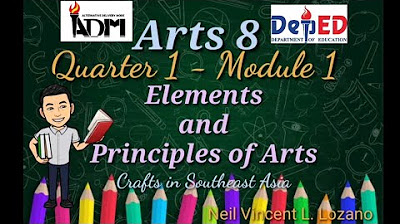ENGLISH 6 QUARTER 1 WEEK 5 - 6 | VISUAL ELEMENTS | MELC-BASED
Summary
TLDRIn this engaging lesson, Teacher FR introduces students to the concept of visual elements in media, focusing on aspects such as lines, space, symbols, color, gaze, framing, and distance. The lesson helps students interpret the meaning behind visual media, explaining how these elements influence perception and communication. Various examples of line types (vertical, horizontal, diagonal, etc.) and their emotional impacts are discussed. Through interactive tasks and quizzes, students learn to identify and analyze visual elements in images, enhancing their understanding of how visuals convey information and emotions. The lesson emphasizes the importance of visual literacy for clearer comprehension.
Takeaways
- 😀 Visual elements include characteristics like line, shape, direction, size, texture, color, and value.
- 😀 Understanding visual elements helps interpret information and avoid misinterpretation in visual media.
- 😀 Lines are categorized into vertical, horizontal, diagonal, zigzag, and curved lines, each conveying different emotions and meanings.
- 😀 Colors have psychological effects, with each color symbolizing specific emotions or traits like red for passion and blue for calmness.
- 😀 Symbols help people recognize and recall images easily, as seen with logos representing brands like Meralco.
- 😀 Framing in visual arts focuses attention on the subject by placing it properly within a frame, enhancing the composition.
- 😀 Gaze refers to how we fix our eyes on a subject, conveying emotions like curiosity or admiration.
- 😀 Space in artwork can be positive (main subject) or negative (background area), influencing how we perceive the composition.
- 😀 Social distance in visual media relates to the gap between the viewer's reality and the fictional world depicted in art.
- 😀 Understanding the purpose of visual media involves interpreting visual elements like color, symbols, and framing to infer meanings.
- 😀 Each visual element (e.g., line, color, space, gaze, framing) contributes to the overall message and emotional impact of an image.
Q & A
What are visual elements in media?
-Visual elements refer to characteristics that can be seen, including line, shape, direction, size, texture, color, and value. These elements are used to convey information and emotions through visual representations.
How can visual elements help readers interpret media?
-Visual elements help readers clarify and comprehend information by allowing them to develop their own perceptions of the content, reducing misinterpretation and making the information more accessible.
What are the five types of lines in visual art?
-The five types of lines are: vertical lines (suggesting height and strength), horizontal lines (indicating calmness and stability), diagonal lines (suggesting movement or instability), zigzag lines (conveying action or excitement), and curved lines (evoking comfort and ease).
What does 'positive space' refer to in artwork?
-Positive space refers to the area of interest or the subject of the artwork, where the viewer’s attention is focused. It is contrasted with negative space, which is the empty or background area.
How does color influence the interpretation of visual media?
-Color can evoke various emotions and associations. For example, red symbolizes passion or danger, blue evokes calmness and trust, and yellow suggests happiness and creativity. Colors are used strategically to convey a particular message or feeling.
What is the meaning of 'gaze' in visual elements?
-Gaze refers to the act of looking steadily and intently at something, often conveying focus, admiration, or curiosity. The gaze can direct the viewer's attention to a specific subject or idea within an image.
What is framing in visual arts?
-Framing is the technique of positioning and placing the subject within a particular boundary, often to highlight the subject and create a visual focus. It ensures that the viewer's attention is directed toward the intended focal point.
What does 'aesthetic distance' mean in the context of visual media?
-Aesthetic distance refers to the gap between the viewer's real-world perception and the fictional or artistic reality presented in a work. It can help in creating emotional or intellectual separation to enhance the viewing experience.
How can symbols be used effectively in visual media?
-Symbols represent concepts or messages that are instantly recognizable, allowing viewers to associate them with specific traits, companies, or ideas. They help in conveying meaning more efficiently than text alone.
What are the emotional associations of the color blue in visual media?
-The color blue typically represents calmness, trust, loyalty, wisdom, and intelligence. It is often associated with peacefulness and serenity, as well as with values like faith and truth.
Outlines

此内容仅限付费用户访问。 请升级后访问。
立即升级Mindmap

此内容仅限付费用户访问。 请升级后访问。
立即升级Keywords

此内容仅限付费用户访问。 请升级后访问。
立即升级Highlights

此内容仅限付费用户访问。 请升级后访问。
立即升级Transcripts

此内容仅限付费用户访问。 请升级后访问。
立即升级浏览更多相关视频

VISUAL ELEMENTS-English 6 Quarter 1 Week 5-6

ENGLISH 6 || VISUAL ELEMENTS

Arts 8 Quarter 1 Module 1 (Elements of Arts and Principle of Design)

ENGLISH 6 QUARTER 2 WEEK 4 - 5 | BIASES AND PROPAGANDA DEVICES

SCIENCE 5 || QUARTER 3 WEEK 2 | CONDUCTORS OF HEAT AND ELECTRICITY | MELC-BASED

AULA DE ARTE- LINHA
5.0 / 5 (0 votes)
